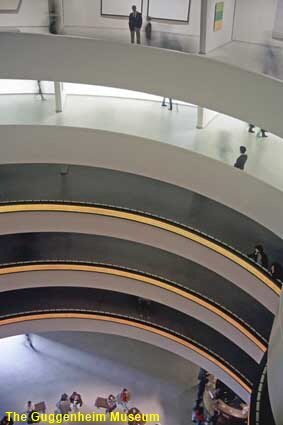Upper East Side
The Upper East Side is the area between Central Park and the East River. Much quieter that the Midtown area, this was where at the end of the 19th century New York’s mega-rich built their city mansions (their ‘country cottages’ out in Rhode Island are covered by the Newport Mansions page). The area remains more residential than midtown and to be a resident, particularly if you want views of Central Park, still requires a huge amount of money. Here 5th Avenue has changed from a shopping street to a mix of expensive apartments interspersed with the museums of ‘Museum Mile’ some of which are housed in former mansions. Offshore in the East River, Roosevelt Island is part of Manhattan even though it is connected to Manhattan only by subway or aerial tramway; the road access to the island is via Queens.
Met Fifth Avenue
Probably the best known of the museums in Museum Mile, and certainly the largest, is the Metropolitan Museum of Art. Known simply as The Met to New Yorkers, the museum covers virtually every form of art from across the world and it has nearly 3 million items in its collection. Founded in 1870 by a group of civic leaders, philanthropists and artists, it moved to its current building on the Central Park side of 5th Avenue in 1880. Even though the museum is huge, it can only show small proportion of its collection at any time. The Museum now has three sites, the original museum shown here is known as the Met Fifth Avenue, its modern and contemporary art museum on Madison Avenue and 75th Street is known as the Met Breuer, while its museum of Medieval European architecture and art in Uptown Manhattan is known as the Met Cloisters.
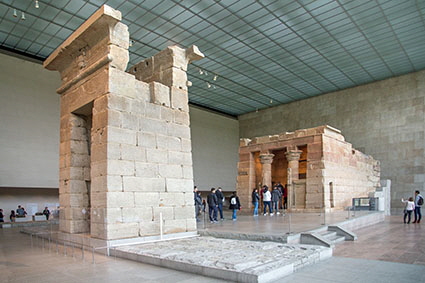
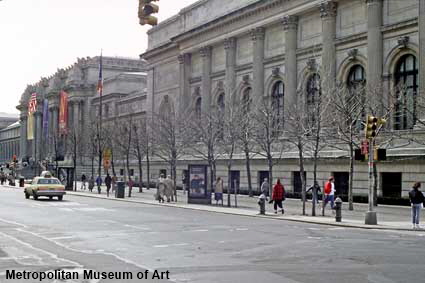
Click on Minimap to navigate
Egyptian Temple of Dendur, Metropolitan Museum of Art
The Met has a truly international range of exhibits. From the entrance in the Great Hall, if you turn right you will find yourself in a large section dedicated to Ancient Egyptian Art. The final exhibit in this section is very memorable, a complete Ancient Egyptian Temple. Built some time between 23 and 15BC, the Temple of Dendur stood on the left bank of the River Nile about 77 kilometres (48 miles) south of modern day Aswan. The building of the Aswan High Dam created Lake Nasser and its rising waters would have drowned the temple, so it was dismantled and given to the United States in recognition its help in saving other monuments from Lake Nasser. Click Tab 2 to see some Egyptian Mummy Cases on display in the museum.
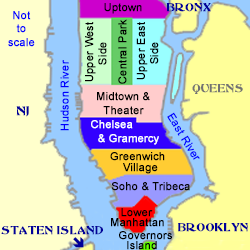
DLU190522


To move forwards or backwards through the Manhattan trail click the arrows above, or select your next destination on the Minimap.

Franklin D Roosevelt Monument, FDR Four Freedoms Park, Roosevelt Island
The southern tip of Roosevelt Island beyond the former Smallpox Hospital, a 1.6 hectare (4 acre) public park has been created in honour of former President Franklin D. Roosevelt. It is named after the four fundamental freedoms that he proposed for all people of the world in a speech in January 1941. These freedoms were freedom of speech, freedom of worship, freedom from want and freedom from fear. At that time World War II was raging in Europe with Nazi Germany having the upper hand, but it was 11 months before the attack on Pearl Harbor brought the USA into the war. After World War I the USA had adopted an isolationist stance and many US politicians wanted to maintain this. Roosevelt’s speech aimed to provide a rationale for the abandonment of that policy. The monument to FDR was designed by Louis Kahn, who died before it was completed. Work on the park did not commence until 2010 and it opened in 2012. From the tip of the island, behind the monument, there is a magnificent view of the United Nations Building. Click Tab 2 to see the UM Building from FDR Four Freedoms Park.
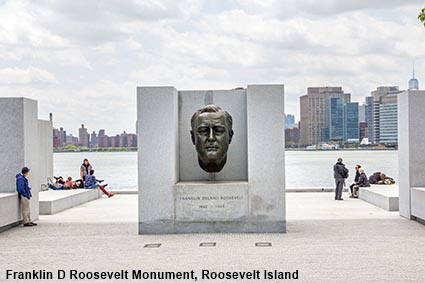
Mount Vernon Hotel from garden
Surrounded by tall modern buildings is a relic of the days when this area was open countryside. It was built as a carriage house in 1799 on a 9 hectare (23 acre) estate. In 1826 the main house on the estate burned down. The carriage house was purchased by Joseph Hart, who converted it into the Mount Vernon Hotel. It was a day resort for New Yorkers wanting a country escape from the city. Guests would arrive by boat at a nearby landing stage on the East River, participate in leisure activities, have a good meal and plenty to drink before catching a boat back to the city. It was possible to stay overnight if needed, but the overnight facilities were extremely basic, you would probably have to share a bed. The hotel operated for only 7 years, in 1833 it was purchased by Jeremiah Towle who converted it to his family home. His family lived there for 72 years before selling it to a gas lighting company. The land on which it stands was once owned by Colonel William Stephens Smith, and his wife Abigail Adams Smith, daughter of 2nd US President John Adams and this link saved it from demolition. In 1924 the The Colonial Dames of America purchased the building and restored it. In 1939 they opened it as an historic house museum called the Abigail Adams Smith House. Research has shown that Abigail Adams Smith never lived on the original estate and in 2000 the name was changed to Mount Vernon Hotel Museum & Garden. It is open 11am to 4pm excluding Mondays and some public holidays. Click Tab 2 to see the Music Room.
Ruins of Smallpox Hospital, Roosevelt Island
In the East River a long, thin island sits just off shore from the Upper East Side. Dutch settlers called it Varkens Eylandt (Hog Island), British Colonists called it first Manning's Island then Blackwell's Island after its owners. In 1828 the city bought the island as a place to put people that it wanted to segregate from the rest of the population. A prison with its own hospital, a lunatic asylum, a workhouse, a smallpox hospital, a hospital for Manhattan’s poor and two hospitals for chronic care, all these were built on the island. In 1909 the Queensboro Bridge opened between Manhattan and Queens; it passed directly over the island but did not provide vehicular access to it. In 1921 the name of the island was changed to Welfare Island. Its isolation ended in 1930 when a vehicular elevator was built to the deck of the Queensboro Bridge. By then the institutions on the island were beginning to close or move away, the last convicts leaving the island in 1935. The Smallpox Hospital had become a Nursing School way back in 1875, an in the 1950s the school closed. In 1955 the island was connected to Queens by a road bridge and the Queensboro Bridge vehicle elevator closed leaving the island disconnected from Manhattan. In 1971 the island was renamed Roosevelt Island after former President Franklin D. Roosevelt and in In 1976 the Roosevelt Island Tramway opened, reconnecting the island with Manhattan. It was not until 1989 that the island was connected to the New York Subway. By then former Smallpox Hospital had become a ruin and in 2007 part of the north wing collapsed. Work is taking place to stabilise the ruins with the objective of opening them to the public. Click Tab 2 to see a Roosevelt Island Tramway Car leaving Roosevelt Island.

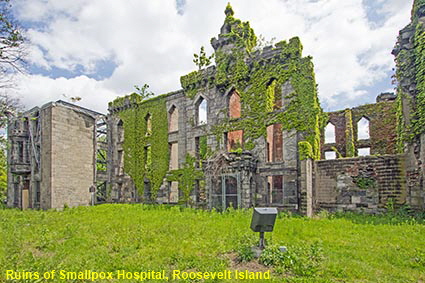
The Guggenheim Museum
The Solomon R. Guggenheim Museum was founded by philanthropist Solomon R. Guggenheim in 1937, the first of a series of museums set up by the family around the world. The Frick Collection and the Guggenheim contrast and complement each other. While the Frick Collection features art up to the late 18th century, the Guggenheim focuses on 19th and 20th century art. While the Frick Collection is in a building that looks understated, the New York Guggenheim is in a building that is probably more famous than its contents. The building is among the best known works of architect Frank Lloyd Wright but it was not completed until just after his death in 1959. The exhibits failed to make us fans of modern art, but the building is very much worth seeing. This picture shows the famous spiral gallery that winds its way up through the building.
Gracie Mansion from East River
Scottish shipping magnate Archibald Gracie built this mansion in 1799, and extended it in 1809. It was Gracie’s country retreat until 1823 when he was forced to sell as a result of financial failure. Although its tree lined location overlooking the East River looks tranquil, the clutter of buildings in the background demonstrates that this Federal-style mansion is a country retreat no more. In 1924 it became the first home of the Museum of the City of New York. In 1942 Fiorello LaGuardia made it the official Mayor's residence, a function that it continues to perform today. There are free tour the mansion most Tuesdays, but you need to book online in advance and you can take nothing bigger than a compact camera into the mansion.
The Frick Collection
The Met Fifth Avenue is big, so big that you are likely to come out with your head spinning. If you want to see classical art in a more manageable quantity then the Frick Collection is highly recommended. Steel magnate Henry Frick filled his Upper East Side mansion with sixteenth to eighteenth century European art. When he died in 1919, Frick left his mansion and art collection to the nation. Although the exterior of the building is a little understated, the interior and the art collection absolutely magnificent.
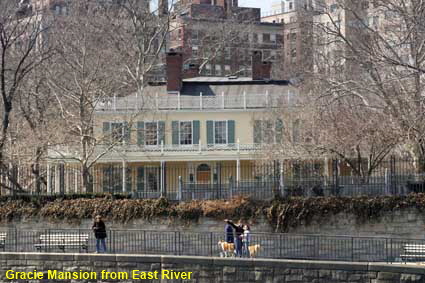
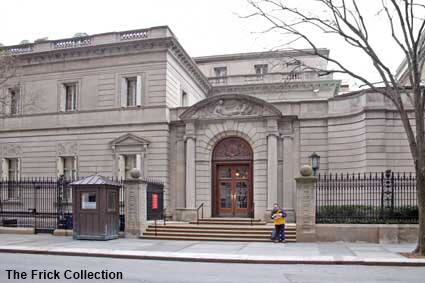
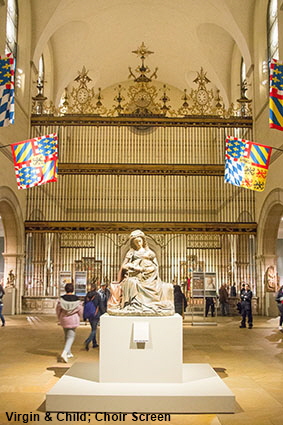
Virgin & Child; Choir Screen, Metropolitan Museum of Art
The largest section of the Met covers European art from sculptures right through to complete furnished rooms from historic European buildings. The Medieval Art Gallery is very church-like with flags hanging from the walls plus religious sculptures and an ornate screen. It felt strangely familiar to us but we could not work out why. Then we saw a sign crediting the Hearst Corporation, and the penny dropped. It reminded us of Hearst Castle in California. The choir screen installed in the gallery is Spanish from the 1763 cathedral of Valladolid. The statue of Virgin and Childe is much older, dating back to between 1380 and 1435. The Met also has an American Wing much of which is devoted to Indian artefacts. Click Tab 2 to see an Alaskan Mask Object dating from around 1900 on display in the American Wing.
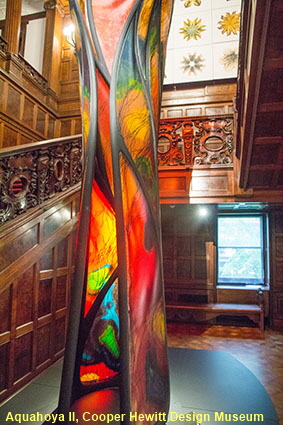
Aquahoya II, Cooper Hewitt Design Museum
The Cooper Hewitt Design Museum is a Smithsonian institution focusing largely on innovative modern design. In the stairwell stands Aquahoya II, a bright sculpture made from biodegradable materials. The museum is full of exhibits of new designs that may become standard in the future, such as a 3D printed airless tyre. If you think the staircase in the picture looks interesting there is a reason for this. The Museum is housed in the historic Andrew Carnegie Mansion completed in 1902. Industrialist Andrew Carnegie lived in the mansion until his death in 1915 and his wife Louise continued to live there until her death in 1946. The mansion is a brilliant example of historic design, but sadly the museum has rather neglected the old in its enthusiasm to show the new. There is no information given about the design of the mansion and in some rooms you find display boards hiding major decorative features such as the fireplace. This is a very good museum, but it would be even better if it made a feature of the building by using it as an example of design and how design has changed over the years. Click Tab 2 to see Fantasma, a silk dress produced with silk from silkworm injected with jellyfish or coral DNA. To the naked eye it glowed an eerie white but in the picture the dress has rendered as blue. Fascinating!
© Mike Elsden 1981 - 2025
The contents of this page may not be reproduced in full or in part without permission
